Electrochemistry Made Easy with Continuous Flow Chemistry Techniques
Even though electrochemistry offers tremendous benefits to synthetic organic chemists, it is rarely used in modern labs because of the lack of suitable equipment that enables non-electrochemists to perform this chemistry in a ‘convenient’ manner. Therefore, chemists will need an easier, more user-friendly way to access this technique for it to become more widely accepted as a routine procedure.
In the past, electrochemistry techniques relied on electrolysis in glass reactors, which resulted in poor reaction control, selectivity, and reproducibility as well as slow reaction rates. Although these systems are simple to set-up, there has been hesitancy to implement them for the reasons already mentioned.
Up until now, the breakthrough of continuous flow electrochemical cells has allowed for selective syntheses with high reactant-to-product conversions, often with only one pass through the device. These devices make electrochemical methods more accessible, resulting in a re-evaluation of the technique as a feasible and appealing synthetic method.
Basic principles of organic electrosynthesis
Organic molecules are activated by the addition or removal of electrons at the surface of an electrode during an organic electrochemical reaction, which is a heterogeneous process. Two electrodes (anode and cathode) in contact with an electrolyte solution is required for an electrosynthetic reaction. An electrolyte is a salt that adds ions to a solution to increase its conductivity.
Electrochemistry can be done in a number of ways, including Potentiostatic mode (where the voltage across the electrodes is controlled) and Galvanostatic mode (where the current across the electrodes is controlled).
Many variables can be analysed in the creation of electrosynthetic methods:
- the nature of the electrode
- the voltage/current applied
- whether the chemistry is performed at the anode or cathode
- whether the electrodes are simply either side of the cell or are separated (e.g. by an ion permeable membrane)
Advantages of organic electrosynthesis
- The potential applied to the working electrode can be used to control the reaction selectivity. It is therefore possible to pick one electrophore over another with a similar structure. Unlike with redox reagents, the potential can be changed at any time
- By adjusting the current density or applied potential it is possible to control the reaction rate
- Similar to classical organic chemistry, it is possible to control the degree of transformation of a molecule (regarding its oxidation state) by managing the number of electrons supplied
- The nature of the electrode and the composition of the electrolyte can be used as reaction parameters to control selectivity and reaction rate
- It is possible to predict the electrosynthetic experimental conditions and pathway
- As electrolysis is performed at room temperature and atmospheric pressure, the reaction conditions are typically mild
Electrochemistry as a “green” application
Since our reaction is performed with the addition or extraction of electrons, it’s easy to consider that our reactions will be REDOX – reductions or oxidations. Electrochemistry can be considered a ‘greener’ technique as it does not require dangerous and polluting reducing or oxidizing reagents such as OsO4, Pb(OAc)4, NaH, and so on.
As our chemistry is mediated by electrons, we often perform it at room temperature thus decreasing energy consumption. We can also think of our electrodes as heterogeneous catalysts resulting in less waste during reaction setup. Besides, ionic liquids are frequently used to substitute organic solvents that are easily recovered.
It is possible to access this greener method and perform unique transformations thanks to the development of continuous flow electrochemical cells, which allow selectivity and transformations not possible with other techniques.
Continuous electrochemistry in flow
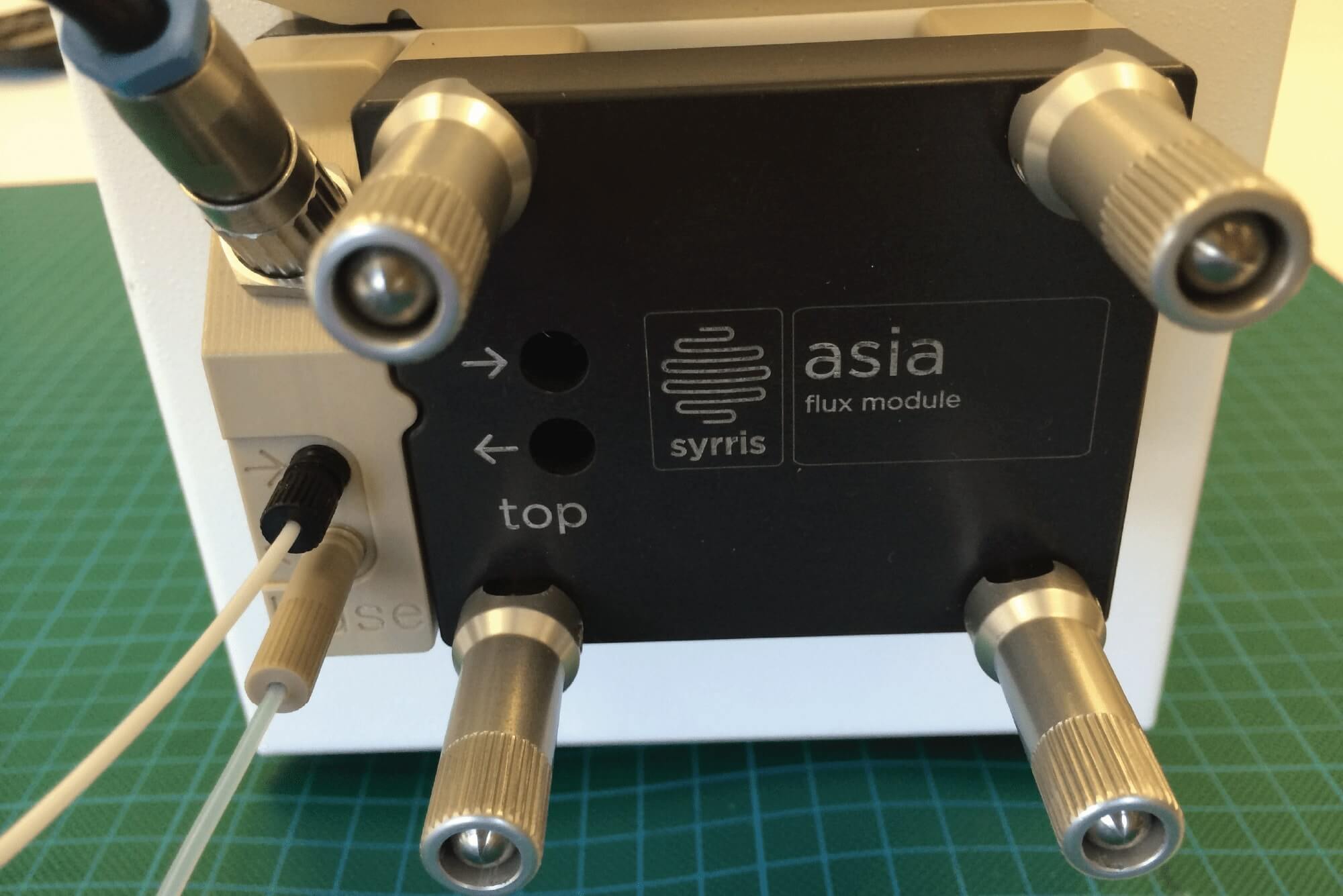
'Beaker cells’ are used in traditional electrochemistry methods. Usually, the exact description of this apparatus is not properly described in electrochemical literature. While the electrode material is provided, the geometries, positioning, and dimensions do not pose any challenges in reproducing experiments. The development of continuous flow electrochemical equipment solves many of the problems with reproducing experimental procedures by limiting variables to the electrode material and the synthetic process.
Electrochemistry is a surface phenomenon, which requires a large surface area to volume ratios. If we are familiar with flow chemistry in general, we will be familiar with this. When compared to similar volume batch reactors, flow reactors have a large surface area to volume ratio. Designing a flow electrochemical reactor with a high surface area to volume ratio in relation to the electrode is not a difficult task.
One thing to keep in mind when it comes to conventional electrochemistry techniques is that the electrodes are separated by a greater distance than their flow equivalent. A loss of control of the charge passing between electrodes due to a large distance between them results in ‘electron gradients’. The diagram below illustrates this with simple oxidation. A range of electrons in our reaction can give rise to a loss in selectivity.
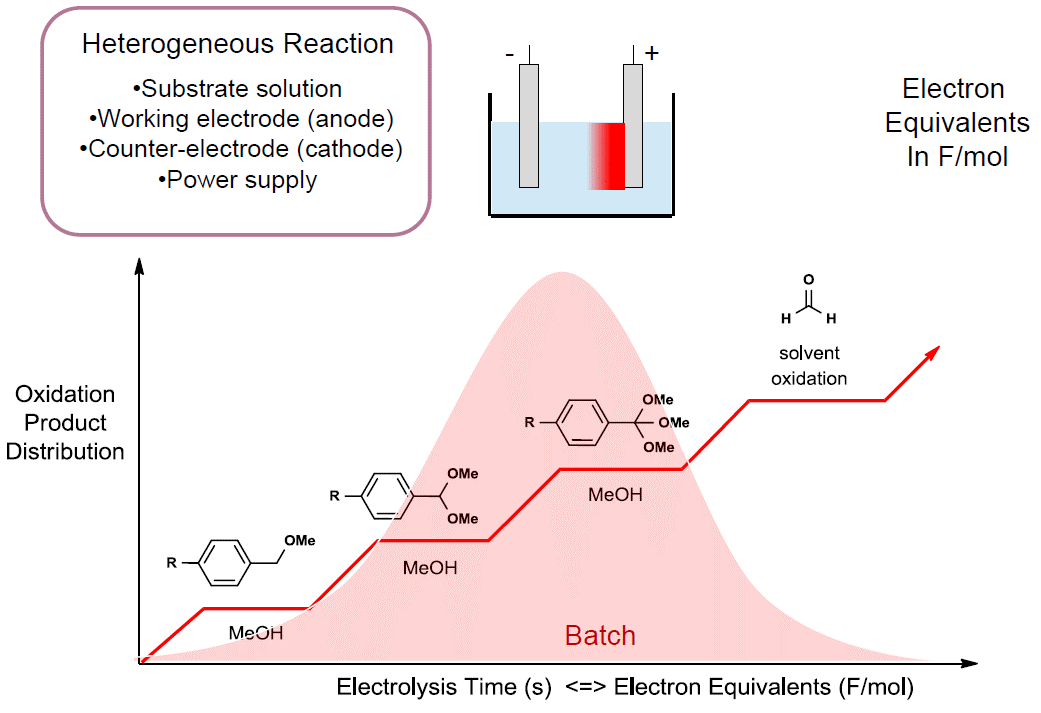
The distance between the electrodes is reduced radically in a flow electrochemical cell. We can accurately control the electron equivalents in our reaction and thus increase selectivity by decreasing the distance between the electrodes.
The majority of continuous flow electrochemistry cells are based on a parallel plate set-up, in which a pair of electrode plates are separated by a small distance by a gasket that creates a flow pathway.
The number of electron equivalents passing between the reaction mixture regulated by the nature of the electrodes and the current or voltage applied across them.
This electron flow can be considered as the reagent. The potential applied across the electrodes to produce the exact number of electron equivalents is determined by the flow rate and concentration of the reaction mixture. This gives us better reagent and selectivity control.
It is possible to reduce or remove the need for electrolytes in our reaction by reducing the gap between the electrodes, which consequently increases their ‘green’ potential.
When we use these continuous electrochemical techniques, reaction throughputs of up to multiple grams per hour can be achieved. Because electrochemistry is surface dependent, increasing the size of the electrodes will potentially increase this even more.
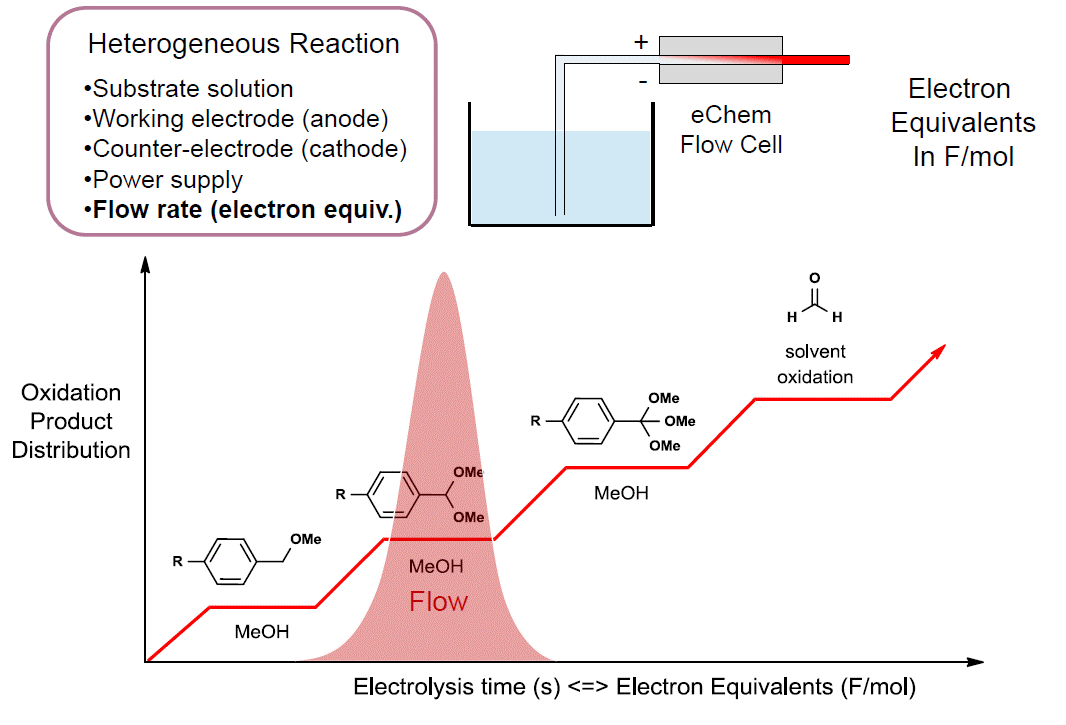
Preparative microfluidic electrosynthesis of drug metabolites: a published example
There are numerous examples of continuous electrochemistry literature that we could discuss here. A simple literature search will provide you with something to read. The direct synthesis of drug metabolites, which is the one we would like to emphasise, is one example of electrosynthesis that is growing in popularity in the pharmaceutical sphere.
Within the pharmaceutical industry, knowing how drugs are metabolised and how they interact in the body is crucial. A thorough understanding of a drug candidate’s metabolites is required before it can be advanced to the next stage of development.
A drug molecule undergoes its first chemical transformation in vivo in the liver, via CYP450-catalysed oxidation. The chemical outcome of the first pass hepatic oxidation is crucial information to any drug development process. However, this often results in a large number of metabolites that need to be elucidated and resynthesized.
In the drug discovery process, a chemist is required to synthesise a targeted compound. Many synthesise need several reaction steps and purifications. A toxicity study is essential to further develop a lead compound if the chemist is lucky enough to obtain one. This results in a number of drug metabolites which themselves require investigation. After that, the chemist must return to the lab and resynthesize these metabolites, sometimes using different methods, which is time-consuming and expensive.
Researchers at the Sanford-Burnham Medical Research Institute, in an effort to replicate these hepatic oxidations, were the first to show that continuous electrochemistry can be utilised to mimic CYP450 oxidation and synthesize oxidative drug metabolite in a single step. This has a huge impact on the whole drug discovery process.
The figure below illustrates the use of a simple electrochemical flow cell and the oxidative pathway in generating oxidative drug metabolites.
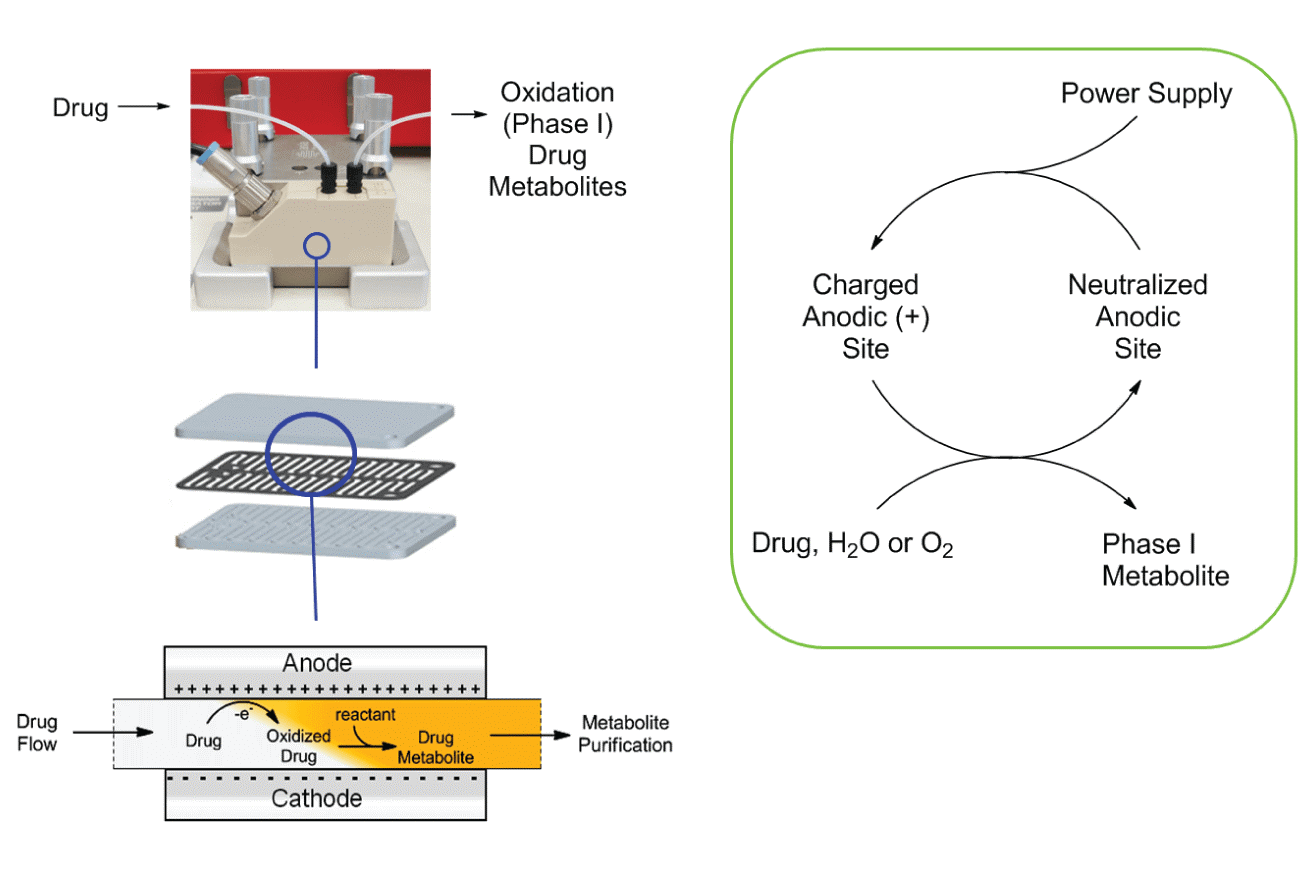
Many commercial drugs were exposed to continuous-flow electrolysis in the study. They were chosen according to their various chemical reactivity: their metabolites in vivo are generated via aromatic hydroxylation, alkyl oxidation, glutathione conjugation, or sulfoxidation. The chemists went on to demonstrate that their metabolites could be synthesized by flow electrolysis with a throughput of 10 to 100 mg/hour, more than enough for further study.
It is important to highlight the precise control of the electron equivalents into the reaction. The example below shows the selective oxidation of Diclofenac, one of the dugs in the study. By controlling the electron flux, we demonstrate the optimization process in converting the starting material to its oxidized product.
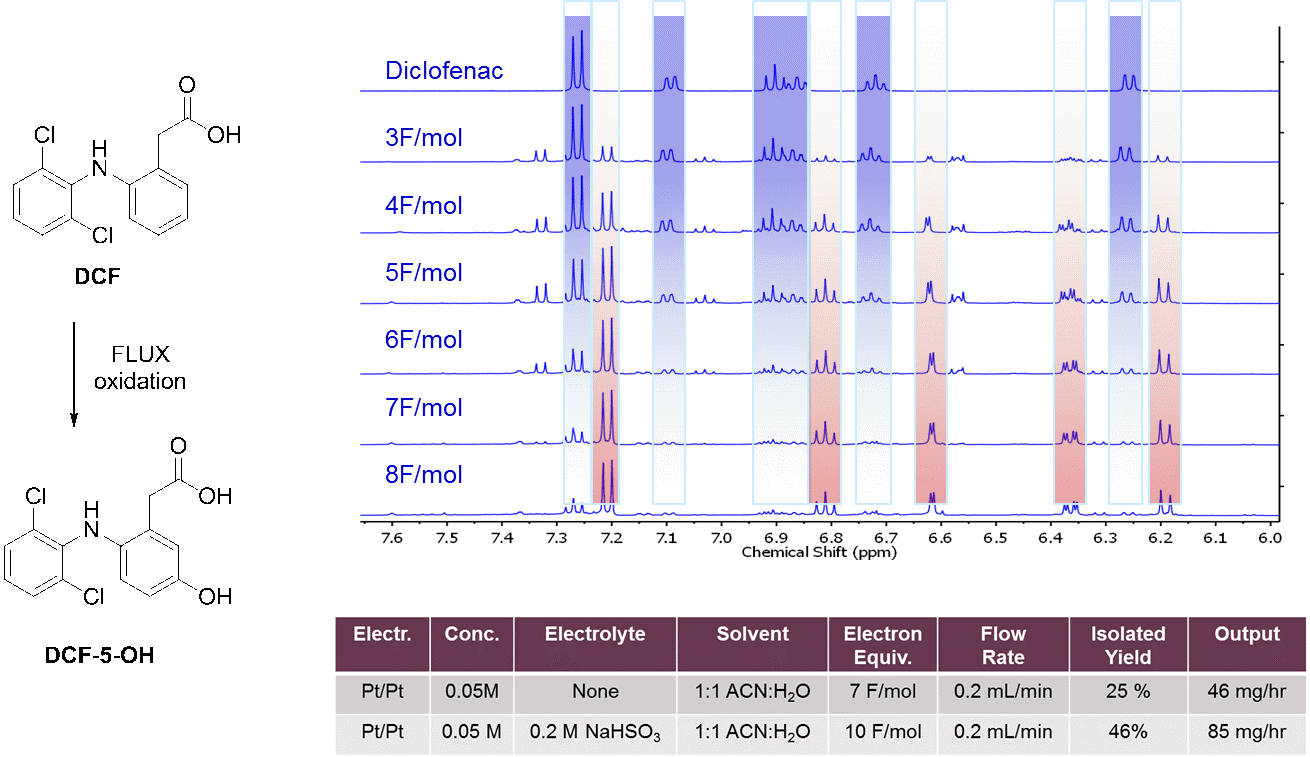
The future of continuous flow electrochemistry
For synthetic organic chemists, the growth of continuous flow electrochemistry methods is expanding their toolbox. The barrier to access this synthetic technique has been greatly reduced thanks to simple reaction set-ups. With the precise control of reaction parameters, flow electrochemistry has the potential for achieve higher selectivities and productivities than conventional techniques. Combined with the greener methodologies, continuous flow electrochemistry offers an exciting prospect for modern chemistry.
Want to know more?
If you are interested to know how you could implement continuous flow electrochemistry into your lab or is already using it and would like to improve your results, contact our Sales Team today.
Contact us Today! |
